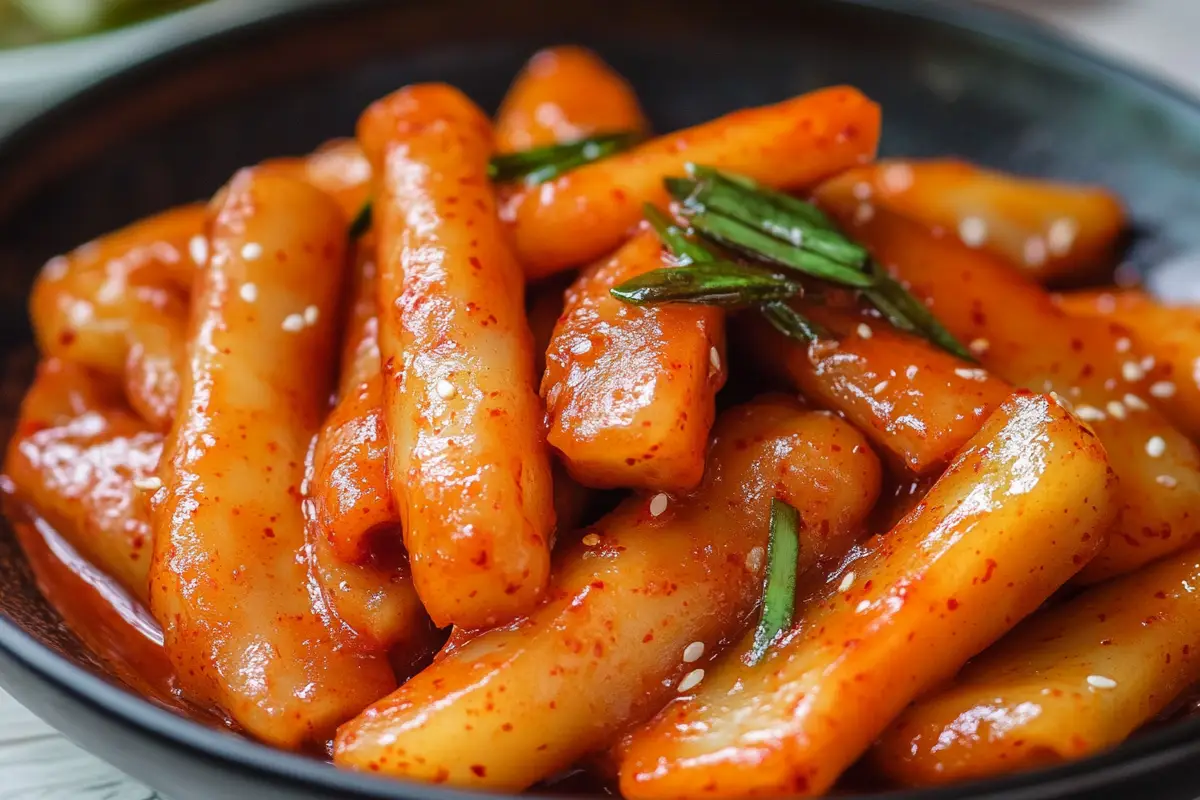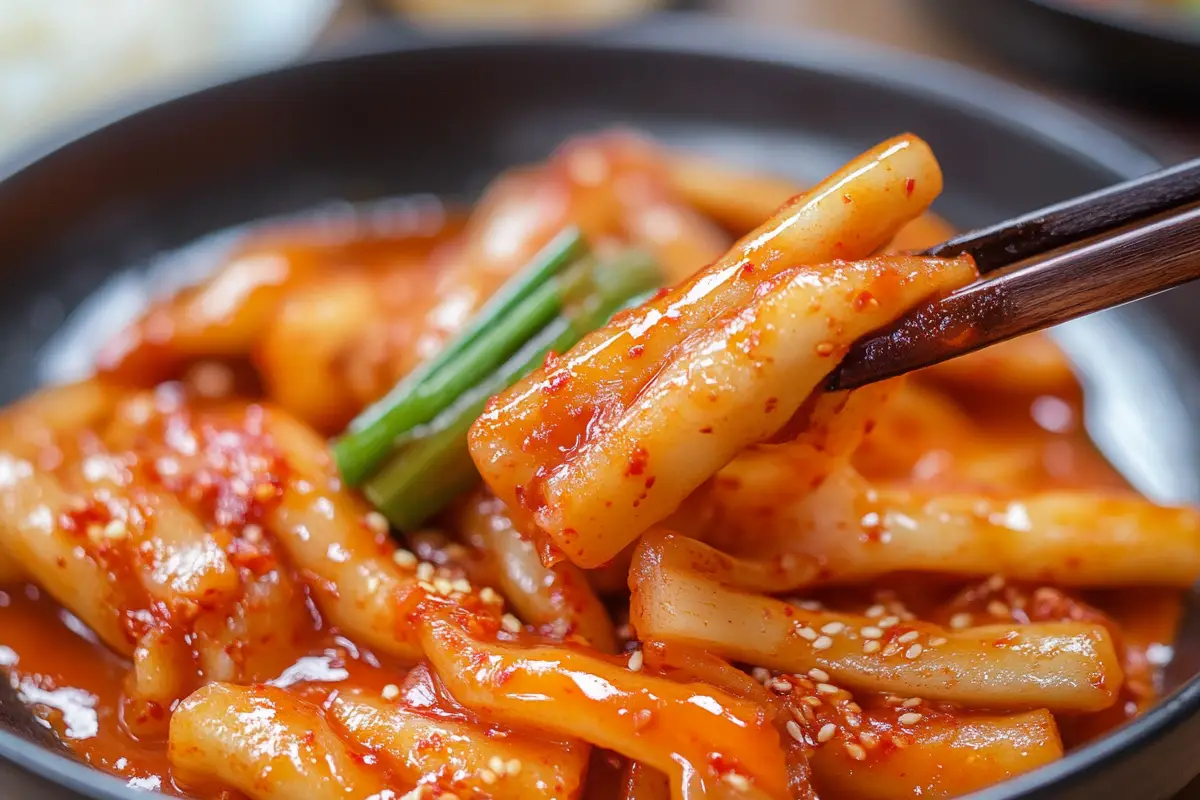What Does Tteokbokki Taste Like? A Flavor Overview
If you’re venturing into the world of Korean cuisine, one dish you should definitely try is tteokbokki. This flavorful, chewy rice cake dish has been a staple in Korean street food for decades, offering a unique blend of sweet, spicy, and savory tastes. But what does tteokbokki taste like? Why is it so beloved by both locals and tourists? This article will dive deep into the dish, exploring its history, ingredients, taste, and all the ways you can enjoy it.
What is Tteokbokki and What Does It Taste Like?
Tteokbokki (떡볶이) is a popular Korean street food made primarily from rice cakes (tteok), which are chewy cylindrical or flat rice cakes that serve as the base of the dish. The rice cakes are combined with a spicy sauce, usually made from gochujang (Korean red chili paste), giving the dish its signature fiery flavor. It’s commonly found sold by street vendors across South Korea, from busy metropolitan cities to small local markets.
Despite its fiery reputation, tteokbokki wasn’t always spicy. Historically, the dish has undergone quite a transformation. The earliest version, dating back to the 19th century, was made with a mild, soy-based sauce, as seen in the ancient Korean cookbook Siuijeonseo. It wasn’t until the 1950s that the modern spicy version, made with gochujang, was accidentally created and became a nationwide sensation. You can learn more about the transformation and recipes in this Easy Tteokbokki Recipe.
What Does Tteokbokki Taste Like? Exploring the Flavor Profile
The main flavors of tteokbokki are a perfect balance of spicy, sweet, and savory. The sauce, made from gochujang, delivers a significant amount of heat, but this spiciness is often tempered by sweetness, typically coming from sugar, honey, or corn syrup, creating a sweet-spicy harmony. At the same time, the dish boasts a savory element due to the inclusion of other ingredients like garlic, soy sauce, and broth. These elements give the sauce depth and balance, making it both fiery and flavorful.
The savory component can be further enhanced by adding anchovy or kelp-based broth, which introduces umami to the dish. This rich combination of flavors is what makes tteokbokki such an addictive and comforting food. The chewiness of the rice cakes adds a unique textural contrast to the soft fish cakes or boiled eggs often included in the dish. If you enjoy dishes with complex flavors, you might also appreciate the bold, umami-packed recipes like this Smoked Meatloaf.
What Does Tteokbokki Taste Like? Understanding Its Unique Texture

While the flavors of tteokbokki are certainly notable, the texture plays an equally important role in its appeal. The rice cakes (tteok) are soft but incredibly chewy, providing a satisfying contrast to the rich, thick sauce. The texture of the rice cakes is often compared to mochi, but denser and chewier, giving the dish a hearty feel despite its status as a snack food.
For many people, it’s the texture that elevates the experience of eating tteokbokki. The chewiness of the rice cakes, when combined with the slick, spicy sauce, provides a bite that’s both satisfying and enjoyable. This distinct mouthfeel is what keeps people coming back for more. The contrast between the chewy tteok and the soft fish cakes or boiled eggs often added to the dish only enhances the texture further.
Popular Variations: How Different Ingredients Change What Tteokbokki Tastes Like
Although the classic tteokbokki is typically spicy, the dish is incredibly versatile and can be customized in countless ways. Here are some of the most popular variations:
- Cheese Tteokbokki: In recent years, the addition of cheese has gained popularity. Melted cheese adds a rich, creamy texture to the dish, perfectly complementing the spiciness of the sauce. The creaminess tempers the heat, making it a perfect introduction for those who may not be accustomed to very spicy food.
- Seafood Tteokbokki: Adding seafood like shrimp, squid, or mussels to the dish enhances its umami flavor. This version is common in coastal regions and Korean seafood restaurants. The natural sweetness and briny flavor of the seafood beautifully complement the spicy gochujang sauce.
- Meat Tteokbokki: Beef or short rib tteokbokki is a more hearty version of the dish. The tender meat adds richness and depth to the flavor profile, making it more suitable as a full meal rather than a snack. This version is quite popular among meat lovers.
- Non-Spicy Tteokbokki: Not everyone enjoys the intense heat of gochujang. For those who prefer milder flavors, there are versions of tteokbokki made with soy sauce or other non-spicy bases. These are often referred to as ganjang tteokbokki and offer a sweeter, less fiery experience.
- Rosé Tteokbokki: A modern twist, rosé tteokbokki includes cream to the gochujang sauce, giving it a rosy color and a much milder, creamier flavor. It’s a trendy dish among younger generations in Korea and offers a perfect balance for those seeking a spicy yet smooth dish.
How to Eat Tteokbokki and Experience Its Full Flavor
One of the things that make tteokbokki so appealing is its versatility in terms of how it can be eaten. While it’s typically enjoyed as a snack or street food, there are various ways to elevate it into a full meal.
As a Snack
Traditionally, tteokbokki is served in small portions as a quick snack. It’s common to see it sold in paper cups or small bowls at street vendors, where it’s eaten with toothpicks or chopsticks. In this form, it’s a filling, inexpensive, and accessible street food that can be enjoyed on the go. You can pair it with other Korean street food items like hotteok (sweet pancakes) or soondae (Korean blood sausage).
With Fried Foods
A popular way to enjoy tteokbokki is by pairing it with fried foods. Many street food vendors sell tteokbokki alongside crispy fried dumplings (mandu), fried tempura vegetables, or even soondae (blood sausage). The contrast between the crunchy fried items and the chewy rice cakes makes for a delicious combination. If you’re planning to serve tteokbokki at home, consider pairing it with fried snacks or these Cheesy Mashed Potatoes to complement the spicy, chewy rice cakes.
In Broth
In some regions, tteokbokki is served with a light broth, which turns the dish into a more comforting and soupy meal. The broth enhances the umami flavor of the dish and makes it even more satisfying on cold days. It’s a great variation for people who want a less intense, more comforting experience. Adding extra vegetables or seafood to the broth can further elevate the flavors.
Tteokbokki as a Full Meal
Although typically a snack, tteokbokki can easily be turned into a full meal by adding more ingredients like boiled eggs, fish cakes, sausages, and even instant noodles (ramyeon). Many people love adding instant noodles to their tteokbokki for an extra layer of flavor and texture. This combination, often called “rabokki,” is a popular option in Korea, particularly among younger crowds. By combining the chewy rice cakes with the soft noodles, you get the best of both worlds in terms of texture.
Where to Get Tteokbokki
Now that you know what tteokbokki tastes like and how to enjoy it, you might be wondering where you can get your hands on some. Fortunately, tteokbokki is widely available, both in and outside of Korea.
In South Korea
In South Korea, tteokbokki is one of the most popular street foods. You can find it in nearly every city, sold at small food stalls, snack bars, and markets. It’s a cheap and filling snack that’s perfect for both lunch and late-night cravings. In many areas, you’ll also find specialized tteokbokki restaurants that offer different versions and endless customization options.
Outside of Korea
If you’re living outside of Korea, you can still enjoy tteokbokki. Many Korean restaurants around the world include tteokbokki on their menus, often serving it with additional ingredients like fish cakes, eggs, and sometimes even cheese. Korean grocery stores also sell pre-packaged kits that make it easy to prepare tteokbokki at home. These kits typically include the tteok (rice cakes) and gochujang-based sauce, and you simply need to add water and any extra ingredients you’d like.
Online
For those without easy access to Korean grocery stores, there are plenty of online options to order tteokbokki kits. Many retailers ship pre-packaged ingredients worldwide, making it simple to make this delicious dish at home. Some meal delivery services even offer tteokbokki as part of their Korean food subscription boxes.
Can You Make Tteokbokki at Home? What Does Homemade Tteokbokki Taste Like?
Yes, making tteokbokki at home is easier than you might think! With the right ingredients, you can recreate this popular Korean street food in your kitchen. If you live near a Korean grocery store, you can find all the essential ingredients there. Alternatively, you can purchase pre-packaged kits online, which often include everything you need, such as rice cakes, sauce, and broth base.
Here’s what you’ll need:
- Rice Cakes (Tteok): Fresh or frozen tteok can be found in Korean markets or online. Make sure to soak the rice cakes in water before cooking if they’re frozen.
- Gochujang (Korean Red Chili Paste): This is the key ingredient for the sauce. It provides both the spiciness and depth of flavor.
- Fish Cakes: These are often added to tteokbokki for extra flavor. They’re thin, chewy, and soak up the sauce well.
- Broth: Most recipes use anchovy or kelp broth, but you can substitute with chicken or vegetable broth if you prefer.
- Sweeteners: Sugar or honey is added to balance the spiciness of the gochujang.
- Vegetables: Green onions, carrots, and cabbage are popular additions.
Once you have your ingredients, making tteokbokki is straightforward. You simply cook the broth, add the gochujang and sweetener, and stir in the rice cakes until they’re soft and chewy. Finish by adding any additional toppings like fish cakes, boiled eggs, or cheese.
FAQs: What Does Tteokbokki Taste Like and More
Is Tteokbokki Always Spicy?
No, while the traditional version is spicy due to the gochujang sauce, there are non-spicy versions like ganjang tteokbokki, which use soy sauce as a base instead. These milder versions are perfect for those who prefer sweet or savory flavors without the heat.
What Ingredients Are Used in Tteokbokki?
The essential ingredients are rice cakes (tteok), gochujang (or an alternative sauce), and broth. Fish cakes, boiled eggs, and green onions are common additions. The dish is highly customizable, allowing you to add various proteins, vegetables, or even noodles to suit your preferences.
Is Tteokbokki Gluten-Free?
Tteokbokki can be gluten-free if you use gluten-free rice cakes and sauce. Some commercial versions of gochujang contain gluten, so it’s essential to check the labels if you have a gluten sensitivity. However, gluten-free versions of gochujang are available.
Can You Freeze Tteokbokki?
Yes, you can freeze tteokbokki leftovers, but it’s best to separate the rice cakes from the sauce before freezing, as freezing can alter the texture of the rice cakes. When ready to eat, thaw the sauce and rice cakes separately and reheat them on the stove.
Conclusion: Discovering What Tteokbokki Tastes Like

Tteokbokki is a bold, flavorful dish that combines sweet, spicy, and savory elements with a chewy texture that keeps people coming back for more. Whether you enjoy it in its classic form, with cheese, or seafood, this iconic Korean street food is sure to leave a lasting impression on your taste buds.
Now that you know what tteokbokki tastes like and how to enjoy it, why not try making it yourself? You can easily find pre-packaged kits at Korean grocery stores or online and experiment with adding your favorite ingredients. And if you’re looking for more recipe ideas to explore. Don’t forget to check out this Tangy Deviled Eggs Recipe to spice up your meal prep.

